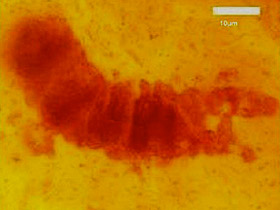
The 31 August 2016 issue of the journal Nature broke the news that some bacteria fossils dating back to 3.7 billion years ago were discovered in Greenland. This news was covered by other publications as well. Even though some scientific publications tried to present this finding as evidence of evolution, in truth, they are the continuation of the previously discovered fossils, proving that life on earth emerged suddenly without undergoing any imaginary evolutionary processes.
SUDDEN EMERGENCE OF LIFE
Life emerged on earth suddenly and in its most complex form. The first known cells are the photosynthesizing cyanobacteria. The Nature article titled "Rapid emergence of life shown by discovery of 3,700-million-year-old microbial structures" tells that the single-celled complex algae emerged without any evolutionary history.
It is obvious that these findings are in total contradiction with Darwinian assertions. Moreover, these fossils belong to organisms that can be called neither simple nor primitive. The said fossils are layered structures formed by the cementation of sedimentary grains by biofilms of cyanobacteria. These are complex microorganisms known for their ability to carry out such a complex process as photosynthesis, certain stages of which continue to remain in the dark.
Even 3.7 billion years ago, cyanobacteria were marvelous and fully equipped life forms capable of making photosynthesis, carrying out nitrogen fixation (nitrogen that cannot be used in a gaseous form assuming the form of usable compounds), capable of movement without the bacterial whip (flagella) and using a string of proteins in order to make such motion possible.
Cyanobacteria fossils were first found in the Chert Region of Western Australia, which were determined to be 3.7 billion years old. Similar 3.5-billion-year-old fossils were also detected in Greenland. These microorganisms, called blue-green algae, emerged in the history of life suddenly and with their flawless structures, and provided the oxygen the Earth’s atmosphere needed. (The Cyanobacteria: Molecular Biology, Genetics and Evolution. Edited by Antonia Herrero & Enrique Flores. p. 217) For a more comprehensive article on the subject, see: http://m.harunyahya.com/tr/buku/152365/Atlas-of-Creation---Volume-4/chapter/14250/Stromatolites-39-million-year-old-living-marvels-that-refute-the-theory-of-evolution.
As opposed to popular belief, the oxygen in our atmosphere is not only produced in forests, but also in the oceans by blue-green algae. Utilizing sunlight, water and carbon dioxide, the algae perform an incredibly complex process like photosynthesis, which would not occur in the absence of even one of its stages, and produce a substantial part of the oxygen on Earth.
Some of the characteristics of cyanobacteria, those marvelous micro-organisms, that refute the claim of the theory of evolution that life forms came into being by chance, may be summarized as follows:
• Cyanobacteria by themselves produce 30% of the Earth’s annual amount of oxygen; that figure is equivalent to the amount produced by all the green plants on Earth.
• These bacteria are very small in size, but their quantity is enormous. There are more than 100 of them in a liter of water, and they account for 10 to 20% of the productivity of the oceans. Despite being invisible, they predominate over a large part of the Earth.
• This form of bacterium is capable of performing very different processes such as photosynthesis, nitrogen fixation (the process whereby nitrogen is turned into a form usable by living things) and respiration, within a single cell. This requires a matchless cell membrane system. For example, the bacteria need an oxygen-free environment for nitrogen fixation, but an oxygen-rich environment for all the other processes, and each of these require different cell membranes. This architecture makes cyanobacteria one of the most complex members of the bacterial kingdom.
PRIMITIVE LIFE NEVER EXISTED
The latest fossil findings featured in Nature once more reveals that there occurred no evolutionary process from the primitive to the developed. Furthermore, the article acknowledges the fact that the complex life, which was determined to be widespread in that period, must have actually begun much earlier as follows:
“This implies that by ~3,700 Ma life already had a considerable prehistory, and supports model organism chronology that life arose during the Hadean (>4,000 Ma).” (Rapid emergence of life shown by discovery of 3,700-million-year-old microbial structures, Nutman et al, Nature, 31 August 2016)
 |  |
Abigail C. Allwood from The California Institute of Technology made the following comment in her article featured in the same journal:
"When did life first arise on Earth? Analysis of ancient rocks in Greenland that contains structures interpreted as bacterial in origin suggests that Earth might have been an abode for life much earlier than previously thought." (Abigail C. Allwood, Geology: Evidence of life in Earth's oldest rocks, Nature, 31 August 2016)
 |  |
CONCLUSION:
The processes that these organisms carry out in their micro-bodies, too small to be seen with the naked eye, exhibit a perfection that today’s advanced technology is nowhere near approaching. Cyanobacteria, which Darwinists claim are “primitive early life forms,” make photosynthesis using sunlight and convert water into oxygen molecules as well as protons and electrons. The structures they use for photosynthesis, known as thylakoids, are located within the folds of the cell membrane. Thylakoids have special antennae known as phycobilisomes that harvest light for photosystems. It is clear that such an architecture is not at all “primitive.”
Considering both their structures and the processes they perform, these 3.7-billion-year-old organisms are not at all primitive, but have been highly complex ever since the moment they were first created.
As it can be seen, the first microorganisms that can be detected are the algae, which continue their existence today in their identical form. At no point in the history of life did a process such as evolution ever occur. The sudden emergence of complex life proves that God created life forms in an instant by His command “Be.”


